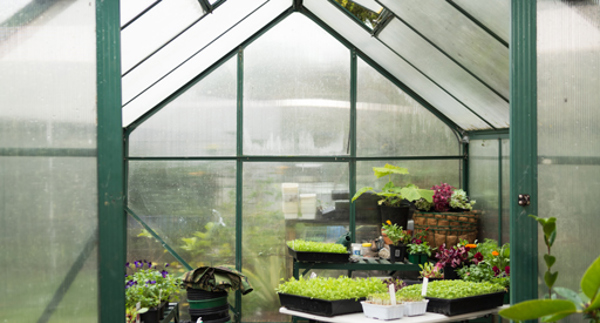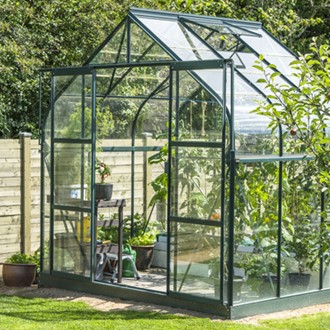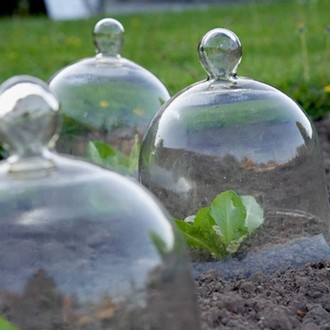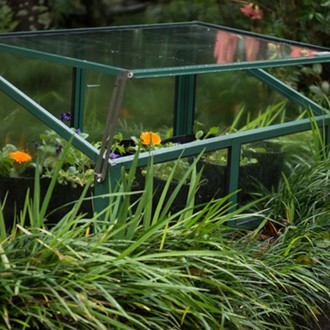
If you love a supply of leafy greens all year round, and enjoy growing your own veges, it doesn't have to stop now that the cold weather has set in. You just need to switch to going under cover.
Greenhouses come in all shapes and sizes and are great for any gardener, regardless of experience.
Especially if you like to grow your own food, greenhouses can extend the growing season of plants that would not usually thrive over winter and allows you to sow seeds earlier than usual. For the thrifty gardener, greenhouses provide the ideal environment for propagating plants from seeds or cuttings.
Advantages of having a greenhouse
- Easier to start plants earlier.
- Plants grow faster and bigger because they are protected against the weather.
- Easier to grow crops that need more heat, such as capsicum, chilli, eggplant and melons.
- Most seeds germinate easier with heat.
You don’t have to go all out and purchase a large greenhouse. If you don't have the space and just want to create a warm, sheltered area for some specific plants, cold frames or cloches are a great option too. You can purchase these relatively cheaply from your local garden or hardware store or even DIY your own using recycled materials.
Greenhouses

Greenhouses come in all shapes and sizes so think about what you want to grow, how much you want to grow and how permanent you want your greenhouse to be before investing.
A level site and permanent spot is required for a greenhouse.
Talk to your local garden centre or a greenhouse supplier about the different materials available and which will best suit your needs.
- Glass provides longevity but doesn’t work as well as polycarbonate in frost-prone areas. Polycarbonate is lightweight and has the added advantage of insulation due to the honeycomb structure of the panels, which are UV stabilised for longevity.
- Polyethylene is a good low cost option but keep in mind the covering will need replacing after five years.
If you start your seeds in a greenhouse, you can start them a good six weeks earlier than usual and transplant them to a cold frame or cloche in the garden. Your greenhouse should be in the sunniest spot in your garden and ideally in a sheltered position away from strong winds.
Leave green house doors open during the day to allow pollinators in.
Cloches

Cloches are the cheapest option and are super easy to use and are relocatable. During the day cloches can be removed, or lift the sides to give the plants a chance to breathe and harden off. Replace or pull down the sides at the end of the day.
- Cut off, recycled clear plastic bottles can create an instant cloche for an individual plant, which can easily be removed during a sunny day and put back when the temperature drops in the afternoon.
- Tunnel cloches made from wire rings and plastic covers warm the soil for seedlings and protect from frost. They are super versatile as they can be adjusted according to what you are growing and can double as protection from birds and insects.
Remember when using the cloche to grow seedlings and plants over winter the cover should always be transparent.
Cloches can also be covered in fine mesh to keep white cabbage butterfly at bay, along with frost cloth to protect tender plants.
Cold Frames

Cold frames are a great option and you can whip up your own DIY cold frame or purchase one. You can create a great looking cold frame with recycled bricks and an old window frame. Or go for a portable cold frame that you can move around the garden as you need to.
- Put your cold frame in a nice sheltered position where the cover of your cold frame slopes towards the sun.
- The cover needs to be able to open to give ventilation to the plants, leave it open during the day and close at night.
- Cold frames are a great way to start seedlings, grow seedlings on and to harden seedlings off. Plants can be grown directly into the soil under the cold frame, or in seed trays and pots ready for planting out.
- Seedlings grown in a cold frame are less likely to get transplant shock as they are better acclimatised.
Planting & sowing
for what to plant in your region.
Sow your seeds as per packet instructions. Once your seeds have germinated they can be planted into larger pots, or plant directly into the ground.
If you are planting directly into the soil in your greenhouse, tunnel house or cold frame, ensure the soil is moist as the soil can dry out quickly, so check and water the soil regularly. Dig or fork Tui Vegetable Mix or Tui Compost into the soil to help retain moisture and enrich the soil. If it is particularly cold when you set up your cold frame, allow 1-2 weeks for the soil in your cold frame to warm up enough to allow planting. Keep the lid closed.
Sowing into seed trays in a greenhouse:
- Fill the seed tray with Tui Seed Raising Mix up to 1cm from the top.
- Level and firm the seed raising mix, then tap the container gently on the ground to settle the mix.
- Water lightly to ensure mix is moist and settled.
- Sow the seeds as directed on the packet.
- Lightly cover with Tui Seed Raising Mix.
- Cover your container with glass or clear plastic to help retain moisture and warmth. Although it’s in a greenhouse covering the tray is still important to retain enough moisture for germination. The seeds don't need as much natural light until they have germinated. Remove the cover as soon as the seeds germinate.
- Place in a warm spot in the greenhouse to grow on.
- Water lightly and regularly. Avoid over watering as this can cause the seedlings to rot.
Once the seedlings have two true leaves and are easy to handle they can be pricked out of the seed tray for growing on into pots filled with Tui All Purpose Potting Mix before planting out.
Planting seedlings grown from seed in the greenhouse or purchased seedlings for the cold frame:
- Once the seedling has two sets of true leaves they are ready to be transplanted into small pots.
- If you are planting from seedlings you have bought, soak plants in their pots or punnets in a bucket of Tui Organic Seaweed Plant Tonic to help reduce transplant shock. gently remove from their container and loosen the root ball.
- Partly fill your container with Tui All Purpose Potting Mix.
- Position the plant in the container. If planting multiple plants, space accordingly in the container.
- Fill your container with Tui All Purpose Potting Mix up to 3cm from the top.
- Press soil gently around the base of seedling.
- Water plants well with the remaining Seaweed Plant Tonic.
- Place the newly transplanted seedlings inside the cold frame.
- Ensure that the seedlings have adequate ventilation during the day but the cold frame is closed overnight.
- Water regularly.
- Once your seedlings have put on good growth you can then move them into the garden as they will be hardened off enough for planting.
Tui Tips
- Plants should only be covered when they need to be protected as the covers prevent fresh air, rain, pollination and often sun which are all essential to healthy plants.
- While covers are on try to water in the morning so that the plants are not damp at night, and try to water the soil, not the leaves to reduce the chance of diseases.
- Don’t leave your plants under the cold frame indefinitely as they will grow tall, soft and leggy, and will need to be exposed to air, rain, pollination and sun.
Post a comment
Greenhouse Growing Guide Comments
I'd placed several sowed seeds in jiffy pots in the green house but less than half of them germinated. Of the half that germinated, most of them died within a week before any true leaves appear. So I think the greenhouse is not suitable for housing seed trays or jiffy pots?
Janet Jin
Hi Janet, the greenhouse might be too hot to raise seedlings in at the moment, especially if there is not shade or protection on the roof.
Seed needs to be fresh before sowing, and need to be stored in a cool dry place where no moisture can come into contact with the seeds, this will keep them viable. The older the seed is and as each year goes by the viability of the seed reduces depending upon how it has been stored.
Try some shade over the glass house and make sure there is good ventilation so that the seedlings don’t “cook”.
Tui Team
I have a greenhouse that was converted from a garage we never used. It has the original roof but the sides have been replaced with corrugated polycarbonate. It's in the full sun and gets warm even on cold days. I have had no luck with any of the green leaf vegetables I've planted. Do you think it is too warm for them? I live In Christchurch.
Lesley Smith
Hi Lesley, it could be getting too hot especially if the polycarbonate is clear. It may need a shade cloth put up in summer or paint the polycarbonate with a very watered down white paint to filter the bright light. You haven't said what is happening to the vegetables - are they not growing? Are they spindly? Have they been planted in a quality potting mix? These are some factors to consider.
Tui Team
Thanks for your reply. Nothing really happens to the vegetables: they just sit there, looking healthy, not spindly, but not growing or developing into whatever they are supposed to be: broccoli, kale, lettuces, etc. The broad bean plants have grown (they are tied up as recommended), but there are no flowers and no beans. I use good quality potting mix and water the plants regularly. I have stated leaving the doors to the greenhouse open all the time to encourage insects to go in and to stop it getting to hot. I am a keen gardener but mostly with shrubs and flowers, this is the first time I have ever had a greenhouse it is turning out to be a steep learning curve for me.
Lesley Smith
If you have space try planting half outside in the garden and half in the greenhouse, to see if it is the conditions in the greenhouse. Also try using Tui Organic Seaweed Plant Tonic. It is great to use to get plants moving and stimulate root growth and improve overall plant health. Use this weekly at a rate of 70ml per 9L watering can. Tui Mini Sheep Pellets would also be ideal for your greenhouse, they are a smaller pellet and easy to apply.
Tui Team
I have whitefly on my tomatoes in the glass house. I am spraying with Mavirk and dont seem to be making any inroads in to killing them. Ideas please
Heather Shannon
Hi Heather, it is always a good idea to alternate sprays as insects build up resistance to insecticides. Whitefly are hard to control as you need to break the lifecycle, winter chilling usually does that but you have a constant temperature in your glasshouse. Try alternating with a pyrethrum based insecticide, make sure when spraying you are covering the underside of the leaf as well as the topside. There are sticky pheromone traps that you can hang in your glasshouse that attract the male and so break the lifecycle, these are available from garden centres, hardware stores and farm merchants.
Lianne, Tui Team
My spinach and salads bolt too quickly... is it too hot? What can I grow in a hothouse. I've tried tomatoes and cucumbers.
Yolandi
Hi Yolandi, bolting means the plant has received a signal either from stress, daylength or temperature that it is time to reproduce itself to ensure survival. Some varieties are more susceptible than others and if growing varieties that are out of season, bolting is likely to occur, for example planting a winter lettuce variety in summer. Spinach and salad vegetables will bolt quickly with a change in season, especially in late winter into spring, going from cooler to warmer temperatures. The key is to keep harvesting from the plants, keep continuously planting, don’t plant everything at once, plant six plants, and in 2-4 weeks time plant another six. Consistent watering and feeding will also help keep the plants actively growing. Spinach can be planted year round, as can lettuce and salad vegetables but in the heat of summer salad vegetables, especially lettuce, will need some shade or protection from the sun. Make sure the seedlings you plant haven’t been in their container for too long as they may be root bound, and will bolt when planted. At this time of the year salad vegetables can be grown outside, but suitable glasshouse crops, depending upon where you are in New Zealand, would be cucumbers, tomatoes, courgette, egg plant and capsicum. Lianne.
Lianne
Hi, I am in Southland and wondering what will grow well in my polyhouse over winter please?
linda robertson
Hi Linda, all plants listed on our planting calendar for Southland will grow in a polyhouse. Carrots, beetroot and peas, can be planted directly into the garden. We suggest planting brassicas (cabbage, cauliflower, broccoli), winter lettuce (mizuna, corn salad or miners lettuce), carrots, beetroot, radish, onion to name a few. Our planting calendar for Southland is here .
Lianne
Great tips, thank you.
Tracy Henderson
Hi, do you have a fruit tree maintenance guide to spray and prepare trees for spring and summer? Thanks.
Hans
Hi Hans, any spray programme needs to take into consideration how it will affect beneficial insects such as lady birds, bees, butterflies and other pollinators. Prevention is the best way to protect your fruit trees, and hopefully reduce the need for a heavy hitting spray programme. Good cultural practices such as consistent watering throughout the growing season, feeding trees to replenish nutrients removed from the soil, and mulching to help conserve soil moisture will grow healthy fruit trees. Planting varieties suited to your climate, planting disease resistant varieties, and pruning trees at the right time of year all help too - stone fruit in summer, pip fruit in winter. Removing infected plant material, as well as fallen fruit will help prevent the spread of disease, burning or throwing infected plant material in the rubbish and not composting prevents pests and diseases multiplying from season to season. However, sometimes there is a need to spray, so in autumn as leaves start to fall apply a clean up spray of a copper based spray and horticultural spraying oil, this will smother any lingering insect pests and insect eggs, as well as fungal spores. Collect up fallen fruit that may be infected with fruit worm, codling moth or guava moth and dispose of in the rubbish. Do the same with fallen leaves that may have black spot or mildews. In winter, continue with the clean up sprays, repeat copper and oil sprays up until early spring. Deciduous trees can be sprayed with Lime Sulphur to control overwintering mites, scale insect and fungal diseases, it is also good for getting rid of moss and lichen on mature trees. Do not spray Lime Sulphur on apricots or other sulphur sensitive plants, and only apply it to deciduous trees not in leaf. In spring continue with protectant copper sprays for fungal diseases up until flowers emerge, hopefully this is enough to keep fungal diseases such as brown rot and leaf curl at bay. Once brown rot is established in plums, peaches and nectarines, it is difficult to control. Keep an eye out for insect pests, use a low toxicity spray or horticultural spraying oil to keep them under control. Always check withholding periods even when using natural controls, sometimes the easiest way to move passionvine hopper and white fly on is to spray them with the hose every few days so that they don't get established. Passionvine hopper is best controlled at the nymph stage. In early spring hang traps in pip fruit to control codling moth to disrupt the life cycle, and guava moth traps from when fruit sets to harvest. Hopefully you have done enough through autumn and winter to keep your garden relatively pest and disease free, and any pests or diseases are easily controlled so that they don't become a problem at harvest time.
Lianne
Hi, I live in Northland, what kind of vegetables should I plant in my greenhouse now for the winter?
kate
Hi Kate, greenhouses are a good environment to get seeds to germinate and for planting seedlings to get an early start on crops, plants grow faster and are protected from the weather. In Northland any plants that are on our planting calendar are suitable to plant, click here, and download the planting poster for a quick reference. At this time of year brassicas such as cabbage, cauliflower, broccoli and Asian greens are good to plant, winter lettuce varieties, spinach and silverbeet, celery, coriander and parsley, there may still be time for peas, beans and broad beans. Depending upon frosts and how cold it gets in your region you may be able to move your chilli plants (in pots) into the greenhouse and they will continue to fruit, make sure pollinators can get in during the day. It will be trial and error, green houses are a great way to experiment with what works in your area and will largely depend upon whether it is a mild winter or not.
Lianne